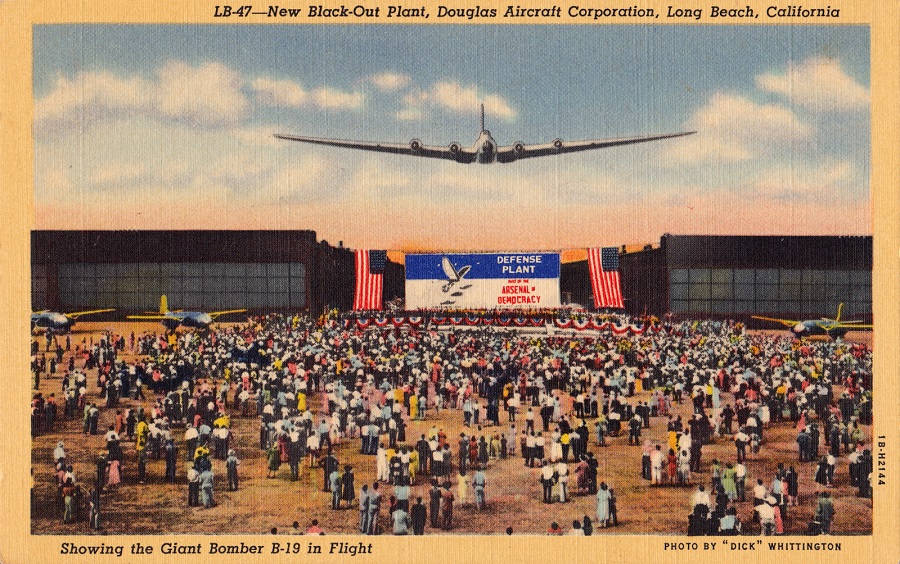Spectators line the fence near Long Beach Airport’s Runway 30, getting their last look at a Long Beach-made Boeing C-17. Photos by Matt Cohn.
On Sunday afternoon, a massive Boeing C-17A Globemaster III left its colossal hangar on the western edge of Long Beach Airport, stopped for a photo opportunity, took off toward the northwest, circled back for a low-altitude flyover, then headed east toward Qatar by way of Texas. It was the final plane built in Long Beach, and its departure marked the end of an illustrious era in California’s aviation history.
Within the roar of the plane’s four mighty turbofan engines, echoes could be heard of the thousands of B-17 “Flying Fortress” bombers manufactured in now-demolished Douglas Aircraft buildings during World War II, and of the countless commercial prop planes and jets built by Douglas, McDonnell Douglas and Boeing in the cavernous buildings east of Lakewood Boulevard.
Many of the spectators lining the fence on Sunday near Runway 30 were former aircraft workers, and they could be overheard reminiscing about aircraft fleets, long nights on the swing shift, Nike missile launchers at the corner of Lakewood Boulevard and Spring Street, and post-work beers at nearby bars like the Flite Room and the Annex.

Postcard from 1941, the year the Douglas Aircraft plant opened in Long Beach.
Douglas Aircraft came to Long Beach in 1941 and immediately began churning out war planes in a “blacked out,” windowless, camouflaged and air-conditioned factory along Carson Street, west of Lakewood Boulevard. At the peak of World War II, a crew of 40,000 Douglas employees (including thousands of “Rosie the Riveters”) worked in shifts, 24 hours a day, seven days a week to keep up with the demand for military planes.
After the war, the L.A. basin became the thriving hub of American aviation and aerospace: Douglas, Boeing and companies such as Lockheed, Rockwell, Northrop and North American drove the industry, and suburbs like Lakewood, Downey and East Long Beach sprang up to house their employees.
After airplane production slowed in the ’70s, the call for a new military transport plane in the early ’80s was welcome news in Long Beach. It resulted in 10 years of development of the C-17 by McDonnell Douglas (McDonnell Aircraft had merged with Douglas in 1967). In 1991, the first C-17 made in Long Beach took its maiden voyage.
The beer tab run up by aviation employees over the decades at the Flite Room bar on Lakewood Boulevard must be in the millions.
The 174-foot-long plane with a 170-foot wingspan became the workhorse of the United States Air Force. Able to take off and land on relatively short runways, the plane can haul an 80-ton payload 2400 miles without refueling. It has provided relief to countries devastated by earthquakes and tsunamis, and has transported thousands of troops and tons of equipment to Iraq and Afghanistan.
When McDonnell Douglas was acquired by its former competitor Boeing in 1997, Boeing continued to build the C-17, and the company sold the plane to allies such as Canada, Australia, India, the United Kingdom, Qatar and NATO.
Eventually, with no more buyers, production of the C-17 ceased.
Long Beach will continue to be a commercial aircraft destination, and Virgin Galactic in Long Beach and SpaceX in Hawthorne will carry the aerospace torch. But Sunday’s rumbling C-17 takeoff signaled the end of a long and vibrant chapter in the history of Long Beach and of American manufacturing.
BOEING C – 17A GLOBEMASTER III FLYOVER OF LONG BEACH AIRPORT, …
On Sunday afternoon, the massive Boeing C-17A Globemaster III left its colossal hangar on the western edge of Long Beach Airport, headed east toward Qatar by way of Texas. It was the final plane built in Long Beach, and its departure marked the end of an illustrious era in California’s aviation history. Video and story by Matt Cohn. Read more: http://bit.ly/1ToIcca
Posted by Long Beach Post on Monday, November 30, 2015

